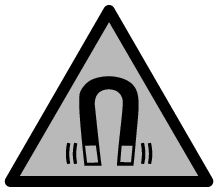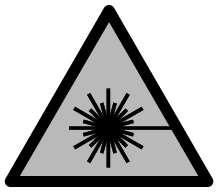Magnetic drill safety warnings
- Operate power tool by insulated grasping surfaces, when performing an operation where the cutting accessory may contact hidden wiring or its own cord. Cutting accessory contacting a “live” wire may make exposed metal parts of the power tool “live” and could give the operator an electric shock.
- When securing the power tool with the safety strap to the workpiece, ensure that the safety strap is capable of holding and restraining the machine during use. If the workpiece is weak or porous, it may be damaged causing the power tool to release from the workpiece.
- When drilling through walls or ceilings, ensure to protect persons and the work area on the other side. The bit may extend through the hole or the core may fall out on the other side.
- The coolant tank may not be used when drilling into vertical or sloped surfaces, or drilling overhead. Please use foam coolant. Take care that no water penetrates the tool. If water penetrates the power tool there is an increased risk of an electric shock.
- The power tool must be secured. A power tool that is not properly secured may move or tip over and may result in personal injury.
- Do not wear gloves. Gloves may be entangled by the rotating parts or chips leading to personal injury.
- Keep your hands out of the drilling area while the tool is running. Contact with rotating parts or chips may result in personal injury.
- Make sure the accessory is rotating before feeding into the workpiece. Otherwise the accessory may become jammed in the workpiece causing unexpected movement of the workpiece and personal injury.
- When the accessory is jammed, stop applying downward pressure and switch off the tool. Investigate and take corrective actions to eliminate the cause of the jam. Jamming can cause unexpected movement of the workpiece and personal injury.
- Avoid generating long chips by regularly interrupting downward pressure. Sharp metal chips may cause entanglement and personal injuries.
- Never remove chips from the drilling area while the tool is running. To remove chips, move the accessory away from the workpiece, switch off the tool and wait for the accessory to stop moving. Use tools such as a brush or hook to remove chips. Contact with rotating parts or chips may result in personal injury.
- Accessories with speed ratings must be rated at least equal to the maximum speed marked on the power tool. Accessories running faster than their rated speed can break and fly apart.
- Use suitable detectors to determine if utility lines are hidden in the work area or call the local utility company for assistance. Contact with electric lines can lead to fire and electric shock. Damaging a gas line can lead to explosion. Penetrating a water line causes property damage or may cause an electric shock.
- Never operate the power tool without the portable residual current device (PRCD) included in delivery.
- Before beginning work, check that the portable residual current device (PRCD) is functioning properly. Have any damaged portable residual current devices (PRCDs) repaired or replaced by a Bosch after-sales service centre.
- Pay attention that neither persons in the working area nor the power tool itself come into contact with the water that comes out.
- Wear non-skid shoes. This prevents injuries that can occur from slipping on smooth surfaces.
- Products sold in GB only: Never operate the 110 V execution of the machine without isolation transformer according to EN/IEC 61558-1 and EN/IEC 61558-2-23. The isolation transformer must have a grounded earth wire on the secondary winding side.
- Never leave the tool unattended before it has come to a complete stop. Drilling tools that are still running can cause injuries.
- Keep the drill cord away from the work area. Damaged or entangled cords increase the risk of electric shock.
- Do not overload the power tool or climb or stand on it. Overloading or standing on the power tool can raise its centre of gravity, causing it to tip over.
- The power tool must only be operated on a mains supply with protective conductor and adequate dimensioning.
- Disconnect the plug from the power source and/or remove the battery from the power tool before making any adjustments to the power tool or changing accessories. Accidents can occur when power tools are started unintentionally.
- When using the power tool for overhead applications, two persons are always required.
- Secure the power tool with a safety strap when drilling into vertical or sloped surfaces, or working overhead. In the event of a power failure or overload, the magnet retention force is not maintained. The power tool may fall over and cause accidents.
- Danger of the power tool falling down due to sudden pendular motion of the power tool. When working on a scaffold, the power tool can be subject to a sudden pendular motion when the drill starts or in case of a power failure. Secure the power tool with the provided safety strap. Secure yourself against falling down by applying a safety rope/belt.
- The surface must be smooth and clean. Smooth out coarse irregularities, e. g., welding spatter and remove loose rust, dirt and grease. The holding force of the magnet applies only for appropriate surfaces.
| Keep the magnet away from implants and other medical devices, e.g. pacemakers or insulin pumps. The magnet generates a field that can impair the function of implants and medical devices. |
- Keep the power tool away from magnetic data carriers and magnetically sensitive equipment. The effect of the magnet can lead to irreversible data loss.
- Secure the power tool on a stable, even and horizontal surface. If the power tool can slip or shake, the application tool cannot be operated evenly and safely.
- Keep the work surface clean, including the workpiece. Sharp-edged drilling chips and other objects may cause injury. Material mixtures are particularly hazardous. Light metal dust may catch fire or explode.
- Do not touch the application tool after working before it has cooled. The application tool becomes very hot while working.
- Do not touch the drill core that will be automatically ejected through the guide pin once the work process has ended. The drill core can become very hot.
- Check the cable regularly and have a damaged cable repaired only by an authorised customer service agent for Bosch power tools. Replace damaged extension cables. This will ensure that the safety of the power tool is maintained.
- Store the power tool safely when it is not in use. The storage location must be dry and lockable. This prevents the power tool from storage damage, and from being operated by untrained persons.
- Never use the power tool if the cable is damaged. Do not touch the damaged cable and pull out the mains plug if the cable is damaged while working. Damaged cables increase the risk of an electric shock.
- Connect the power tool to a mains supply that is properly connected to earth. The socket and extension cable must have a fully functioning protective conductor.
Products sold in GB only:
Your product is fitted with an BS 1363/A approved electric plug with internal fuse (ASTA approved to BS 1362).
If the plug is not suitable for your socket outlets, it should be cut off and an appropriate plug fitted in its place by an authorised customer service agent. The replacement plug should have the same fuse rating as the original plug.
The severed plug must be disposed of to avoid a possible shock hazard and should never be inserted into a mains socket elsewhere.
- The retention of the magnets depends on the thickness of the workpiece. They hold best on low-carbon steel with a thickness of at least 20 mm. When drilling into thinner steel, an additional steel plate (of at least 100 x 200 x 20 mm) must be placed under the magnetic base. Ensure that the steel plate cannot fall off.
- Metal chips and other debris will seriously hamper magnetic adhesion. Always ensure that the magnetic base is clean.
- Avoid the magnet releasing. Ensure that the magnetic base has properly adhered to the work piece before beginning drilling.
- Do not switch off the magnetic power or use the reverse drilling function before the power tool comes to a complete stop.
- Other units used on the same receptacle will cause uneven voltage that could lead to the magnet releasing. Always use the power tool alone on the receptacle.
- Avoid operating annular cutters without coolant fluid. Always check coolant level before operating.
- Protect the motor. Never allow coolant fluid, water, or other contaminants enter the motor.
- Metal chips are often very sharp and hot. Never touch them with bare hands. Clean up with a magnetic chip collector and a chip hook or other appropriate tool.
- Never attempt to use the power tool with incorrect current or abnormally low voltage. Check the nameplate of the power tool to ensure that correct voltage and frequency are used.
- The power tool is delivered with a laser warning sign (see table: "Symbols and their meaning").
- Never make warning signs on the machine unrecognisable.
| Do not direct the laser beam at persons or animals and do not stare into the direct or reflected laser beam yourself. You could blind somebody, cause accidents or damage your eyes. |
- If laser radiation hits your eye, you must close your eyes and immediately turn your head away from the beam.
- Do not make any modifications to the laser equipment.
- Do not let children use the power tool unsupervised. They could unintentionally blind themselves or other persons
- If the text of the laser warning label is not in your national language, stick the provided warning label in your national language over it before operating for the first time.

